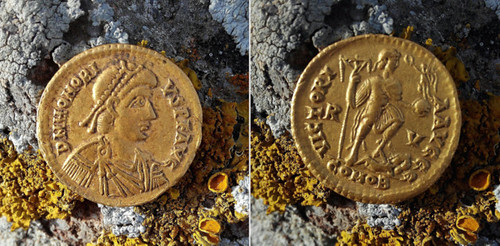
PREV ARTICLE
NEXT ARTICLE
FULL ISSUE
PREV FULL ISSUE
BYZANTINE COIN FOUND IN CARTAGENA COUNTRYSIDE
There's just no end to the stories of coin finds. Here's a decent Byzantine solidus found recently near Cartagena.
-Editor

A gold coin dating from the late 4th or early 5th century has been donated to the Department of Culture in the Byzantine coin found in Cartagena countryside Town Hall of Cartagena, and is being kept in the Museo Arqueológico until it is decided which museum it will be displayed in. The Byzantine solidus coin, which has a diameter of 21 millimetres, was found completely by chance when members of the ANSE naturalists association were enjoying a walk, and was minted in Ravenna (still containing stunning Byzantine mosaics) in the north of Italy during the reign of Emperor Honorius, who was in power from 385 to 423 AD. It is a relatively rare coin, firstly because it was not often used due to its high value, and secondly because most solidi were melted down after being taken out of circulation in order to re-use the gold. In fact, there are only two others currently in the museums of the Region of Murcia. Around the bust of Honorius on the coin it is possible to read the inscription “DN HONORI-VS P F AVG” (Dominus Noster Honorius Pius Felix Augusto), while on the other side the image portrays the figure of the Emperor as a foot soldier. The solidus was first introduced by Constantine the Great (324-337) to replace the aureus as part of a monetary reform which helped to stabilize the economy of the Roman Empire, and was later an important element of the economy of the Byzantine Empire (or Eastern Roman Empire). It remained in use in the west until the 9th century and in the east until the 11th century, and was often used in international trade, its longevity being due to its weight and the purity of the gold it contained. The Byzantines were in Murcia for just a short period, as the bloated Roman Empire collapsed and split. By the 3rd century the vast Empire was falling apart and by the middle of the 4th century waves of Vandals and Goths had begun to gain European territories from Rome. By 476 much of Western Rome was gone and the power base was with the Eastern half of the territories, ruled from Constantinople.
To read the complete article, see:
The Numismatic Bibliomania Society is a non-profit organization promoting numismatic literature. See our web site at coinbooks.org. To submit items for publication in The E-Sylum, write to the Editor at this address: whomren@gmail.com To subscribe go to: https://my.binhost.com/lists/listinfo/esylum All Rights Reserved. NBS Home Page Contact the NBS webmaster 
|